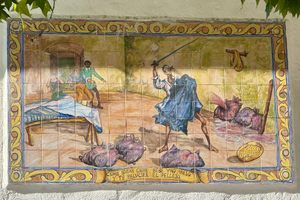Wine cooperatives are a hallmark of La Mancha, with nearly every town boasting one. However, not every town in the region enjoys the distinction of being mentioned in Cervantes’ Don Quixote. Quintanar de la Orden is one of the fortunate exceptions, appearing twice in the novel.
La Mancha’s wine production is essential to its identity and economy. Its flat terrain, abundant sunshine, and minimal rainfall create ideal conditions for cultivating Airén and Tempranillo grapes, making it one of the world’s largest wine-producing regions. These versatile wines drive rural employment, preserve cultural traditions, and have earned global recognition through Denomination of Origin (D.O.) certifications. Cervantes immortalized wine’s role at the heart of Spanish culture in his novel.
In Don Quixote, wine symbolizes indulgence and wisdom. It mirrors Sancho Panza’s earthly pleasures and contrasts with Don Quixote’s lofty ideals. Cervantes uses wine to explore themes of reality, illusion, and human nature, often critiquing folly and celebrating cultural values.
On February 16, 1954, 59 local winegrowers founded the Nuestra Señora de la Piedad Wine Cooperative in Quintanar de la Orden, Toledo, to preserve this legacy. Now known as the Entremontes Winery, its building features tile mosaics adorned with passages from Don Quixote, connecting its winemaking heritage with Cervantes’ enduring masterpiece.
